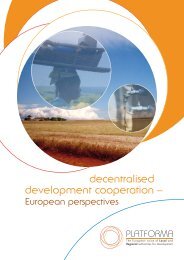Complementarities between urban and rural areas in promoting ...
Complementarities between urban and rural areas in promoting ...
Complementarities between urban and rural areas in promoting ...
Create successful ePaper yourself
Turn your PDF publications into a flip-book with our unique Google optimized e-Paper software.
COMPLEMENTARITIES BETWEEN URBAN AND RURAL AREAS IN PROMOTING EMPLOYMENT AND SOCIAL INCLUSIONIntroductionJorma Palola, Permanent Representative, Association of F<strong>in</strong>nish Local <strong>and</strong> Regional Authorities (AFLRA)This sem<strong>in</strong>ar, jo<strong>in</strong>tly organised by CEMR <strong>and</strong> theAssociation of F<strong>in</strong>nish Local <strong>and</strong> RegionalAuthorities, sought to br<strong>in</strong>g together two important<strong>areas</strong> of CEMR’s work: employment <strong>and</strong>social policy with cohesion policy. These <strong>areas</strong>addressed the common theme of complementarities<strong>between</strong> <strong>urban</strong> <strong>and</strong> <strong>rural</strong> <strong>areas</strong> <strong>in</strong> promot<strong>in</strong>gemployment <strong>and</strong> social <strong>in</strong>clusion. Representativesfrom regional authorities, academia<strong>and</strong> the European Commission participated <strong>in</strong>this event.Globalisation, the EU’s <strong>in</strong>ternal market policy<strong>and</strong> enlargement all strongly affect conditionsof social <strong>and</strong> economic welfare. Employment,social <strong>in</strong>clusion <strong>and</strong> regional development, thema<strong>in</strong> topics of this sem<strong>in</strong>ar, are essential for thewell be<strong>in</strong>g of all citizens. It is important toemphasise that these <strong>areas</strong> are closely <strong>in</strong>terconnected.The role of regional <strong>and</strong> local authoritiesis also significant <strong>in</strong> the practical application ofthese policy <strong>areas</strong>. Local democratically electedbodies have a specific role <strong>in</strong> translat<strong>in</strong>g the EU’s<strong>in</strong>itiatives <strong>in</strong>to local actions <strong>and</strong> <strong>in</strong> channell<strong>in</strong>glocal <strong>and</strong> regional needs <strong>in</strong>to national <strong>and</strong> EUdecision-mak<strong>in</strong>g. There is significant overlap<strong>between</strong> these different <strong>areas</strong> of policy.Problems of employment <strong>and</strong> social <strong>in</strong>clusioncan have specific <strong>rural</strong> <strong>and</strong> <strong>urban</strong> features.However, it is evident that these problems are<strong>in</strong>terdependent. For example, <strong>in</strong> F<strong>in</strong>l<strong>and</strong>, consequencesof substance abuse are often visible <strong>in</strong>both cities themselves <strong>and</strong> <strong>in</strong> their surround<strong>in</strong>g<strong>rural</strong> communities. This is one symptom of the<strong>in</strong>terrelations <strong>between</strong> <strong>urban</strong> <strong>and</strong> <strong>rural</strong> problemsthat needs to be tackled today. These problemsraise the question of how we could createmutually supportive policies <strong>and</strong> practical measuresof implementation to achieve a balanced<strong>urban</strong> <strong>and</strong> <strong>rural</strong> development.The fact that the European Union is revis<strong>in</strong>g itsemployment, social; cohesion <strong>and</strong> agriculturalpolicies, <strong>in</strong> view of the forthcom<strong>in</strong>g enlargement,gives a particular pert<strong>in</strong>ence <strong>and</strong> contextto these discussions today. In the com<strong>in</strong>gmonths, member states will also discuss <strong>and</strong>— 4 —














![[ ] Les jumelages pour le monde de demain](https://img.yumpu.com/29721946/1/190x96/-les-jumelages-pour-le-monde-de-demain.jpg?quality=85)

